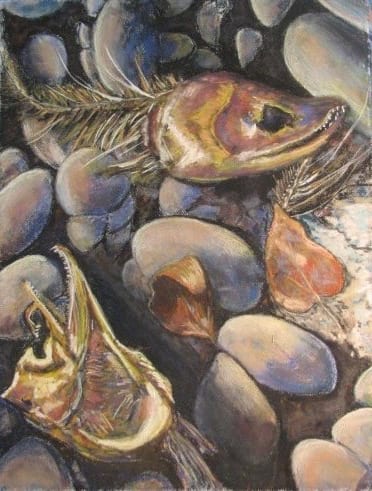In the fateful ways of fortune, we are fortunate to still have clean wild salmon habitat, the fortunate harvest of salmon we’ve come to count on, as does the many creatures in the web of life all around us.
If there is a town on Earth that has a fortunate dependence on salmon, it’s Cordova.
I caught my first red salmon in the early ’70s, growing up fishing the Kenai River. Back then, there was only one fishing guide on that river, Spencer Devito.
I started commercially with crab fishing in Kodiak in the early ’80s, and every year since have setnetted, seined or driftnetted salmon. Alternatively, during the ’80s, I worked on Kodiak and Afognak doing remote salmon aquaculture and fishpass work for the Alaska Department of Fish and Game, and then working for Prince William Sound Aquaculture, at AFK, Main Bay, and Esther hatcheries doing egg takes and other tech work. I fed feed to fry in net pens at Lake Bay before Esther hatchery was built. I setnetted in Main Bay from 1984 to 1996 and was there during the spill. I remember Exxon’s mode and motives.
I bought into area E drift gillnetting in 2000, and have fished the bowpicker Saulteur since. Just a little about where I’ve come from, developing a meaningful connection to salmon, my fortunate dependency. Now, to where we’ve been.

The first regulatory attempts at salmon management were in Scotland around 1030. In 1650, Izaak Walton wrote in The Compleat Angler about Europe’s abundant salmon, where they now no longer exist. By 1850, half of the salmon runs of the eastern U.S. were lost to habitat destruction, and in the 1930s, Washington state voters passed an initiative to ban fish traps, but not dams.
The Columbia River, once the largest system of salmon habitat on Earth, is now a splintered fraction of what was left 100 years ago.
Nobody wanted to exterminate salmon; it was a consequence of habitat loss and biological realities not understood. Alaskans don’t have the excuse of not knowing or are immune from the consequences of ignoring what we do know. We’re fortunate that democracy allows for a citizen initiative like YES for Salmon, and I personally collected signatures to get it on the ballot. The current regulations in place have worked well for the past, but proposals of the future include the Pebble mine and Susitna dam, in known productive salmon habitat, and not the scale of development’s past. Things have changed since 1959.
Ballot measure one, if passed, will not change the way hatcheries, and processors, operating now are regulated or permitted. It would only pertain to new development, and only pertain to whether or not there is, and to what extent harm may be caused to habitat. It would also allow for more public notice and involvement.
Much can be learned by going to standforsalmon.org, I’ll not go into the finer points, but the intent. If you’re invested in a salmon fishery, if you keep the sun off your gillnet, and keep your fishing boat up, if you’re invested in the future harvest of salmon, why not invest your vote to help allow the preservation of productivity through habitat protection upgrades?
Stand for this, or stand for that, we’ve got to work together to ensure the future productivity of our salmon.
To assume Stand for Alaska’s stance that it’s the Alaskan thing to do, to fight other Alaskans simply trying to preserve our most important renewable resource, is destructive in itself and not in the best interests of any of us.
Not in our best interests, but, perhaps for Stand for Alaska’s financial backers, like Exxon, remember them?
If Alaskans can’t preserve our own salmon habitats then who can, or will? I feel a profound responsibility to help at sustaining a continuance of our fortunate dependencies on wild salmon.
I will be voting YES for Salmon in November and I hope that you in salmon town Cordova will too. Thanks for considering my comments.
Poem: Deposit
What of Human investments,
what do they mean,
and what are the gifts that come in with the Streams?
And our Human economies what do they mean
to Biology’s truth at the Bank
of the streams?
At returns Nursery,
in its link to the Sea
where if just left alone
continuance would be
But if Gifts are for taking
for the Eagles in trees
for the Gulls on the sandbars
for the stakeholders needs
With our minds about budget, that can live beyond means, if giving’s what gives
then what gives is the Streams. Unless giving is giving by just letting be
by Humans grown conscious
by takes scarcity
Our Human economies
What do they mean
concerning these matters
at the Bank of the Streams
where Deposits are made
and then left to grow
for the gifts of the Salmon
and a life they can know
it’s this Gift of themselves
that’s Biology’s truth
Let’s give Salmon Deposits
Yes given from you
Yes and given from me
Conscious of truth
For continuance to
No more blaming to
For continuance to be
it’s now, or past due.















